Conrad was now age 43 and entrenched with his wife’s family the Broyles. Both families in 1780 moved southwest to Washington County, North Carolina. The County had just been established in 1778 two years prior. All of the area we now call Tennessee was the Washington District of North Carolina (see map on top right). Settlers were living in small communities along major rivers. Conrad made this move during the American Revolution. All the children were living at home and even the oldest sons age 22 and 18 participated in the move. A few years later, Conrad’s wife dies, and indications are that Conrad then served in the Revolutionary War during the final year of war in 1783. The residents of this area helped defeat the British in the battle of King's Mountain in South Carolina. We have a Revolutionary War pay voucher issued to Conrad. During the war years and beyond, there were still battles with the Cherokee Indians as well. Conrad was one step ahead of the Indian Treaty Line, which caused problems. Even 13 years after Conrad had already moved into the area, fifteen Indians attacked the house of a neighbor on Camp Creek. They shot his wife in the head, wounded a young woman and caught a small girl and scalped her. Mr Woolsey was shot in the breast and hand.
In August of 1790, President George Washington addressed Congress on the problems of East Tennessee, stating that approximately 500 families had settled on Cherokee Lands (Conrad and his kids were among these people). President Washington asked congress to either enforce the boundary of 1785, or make other arrangements with the Cherokees. Congress went to work on the problem and 2,500,000 additional acres were purchased from the Cherokees. By 1798, another million acres were added. This process would go on until 1838, when all Cherokee lands were ceded in one way or another until the Cherokees and neighboring tribes would be removed to Oklahoma along the tragic Trail of Tears.
WillhiteWeb.com
Conrad Reuben Wilhoit/Wilhite
Conrad Wilhoit, was born in 1737 at site 2, the first generation not to experience the period in Germania. At age 21, he married Elizabeth Broyles (also from Germania families). At age 25, he inherited 200 acres when his father Tobias passes. Once married, he became very involved with his wife's family, the Broyles. His wife’s brothers Adam, Nicholas and Mathias are all land swapping and Conrad was a witness to their land deals, baptisms and christenings. One of the Broyles brothers is also married to Conrad’s sister Mary Wilhite. Conrad had most of his kids at the Madison Virginia location (site 2). At age 35 he purchased 139 acres from Adam Broyles. At age 38, Conrad sold 100 acres on Deep Run to his brother Michael.
The black line today is called Wilhoit Road, it passes through Horse Creek (Site 3).
Born in 1737 in the Robinson River Valley, Culpepper/Maddison, Virginia
Died on February 17, 1809 naer Jacksbroro, Campbell County, Tennessee
Around 1780, Conrad Reuben Wilhoit moves to North Carolina
Horse Creek of the Nolichucky River (Site 3)
Was part of Washington County, North Carolina until 1783
Was in the (unofficial) State of Franklin 1784-1788.
Became Greene County, North Carolina in 1783
At Tennessee Statehood in 1796, it became Green County, Tennessee.
Still Green County, Tennessee today.
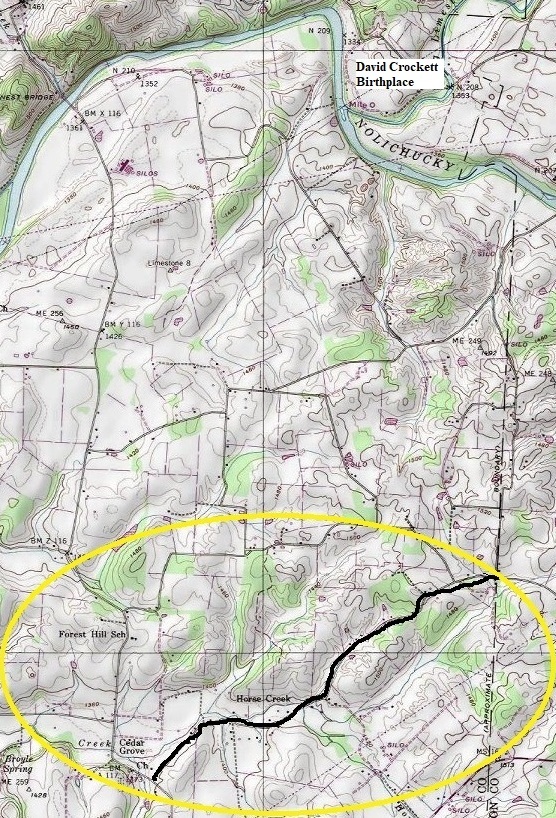
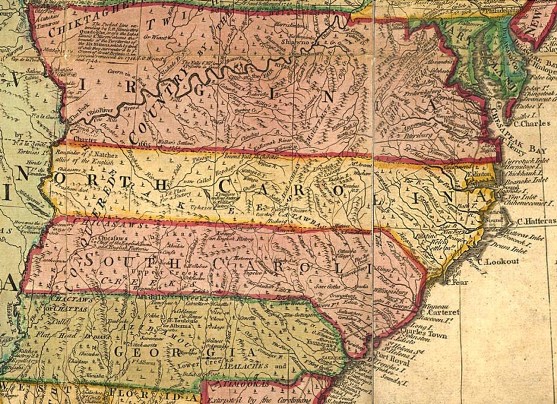
All of the area we now call Tennessee was the Washington District of North Carolina.
Just after the Revolutionary War in 1784, Conrad and Mathias Broyles purchased 200 acres on the south side of the Nolichucky River, on Horse Creek. A few years later they purchase another 200 acres. Conrad is named on many road committees in the area. Others from Germania also traveled to this spot to settle. Today, the road going through the Horse Creek property is called Wilhoit Road (see topo map on right).
Most of the early settlers came on foot or with a horse. In later years they came in wagons. Usually, they found their place near a spring of water, they next fell some trees to build a log cabin, and then started clearing some land. The cabins were usually very crude with a fireplace made of stone chinked with clay. They raised their own food or found it in the forest. Salt had to be imported and was very expensive. Clothes were simple and crude. The wool was raised at home, sheared, cleaned, carded, spun, dyed and finally sewn into shirts, dresses and coats. Breeches for everyday were made from deerskin. One of the nearby neighbors less than a mile away happened to be the Crockett Family and Davie Crocket was born and raised during the time of the Wilhite’s were living next to him. The Crocket property is now a State Park devoted to his historic preservation (see topo map below for where he was born).
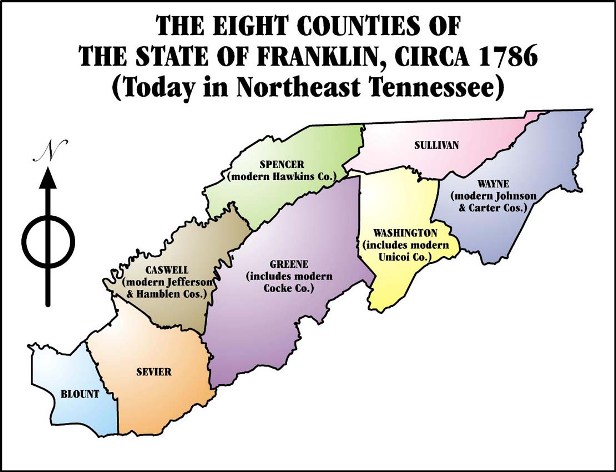
Five years after arriving at Horse Creek on the Nolachuckey, North Carolina ceded the land to the U.S. Government. The Washington County they settled on now became Greene County, North Carolina. When North Carolina did this, these residents west of the Appalachian Mountains indignant at being transferred without their consent, rebelled forming their own state called Franklin and elected the American soldier John Sevier as their Governor. Congress ignored the request of the State of Franklin to be recognized as a state of the Union, and in 1788, North Carolina legislated the State of Franklin out of existence. With Franklin disbanded after four years, the region was again North Carolina. Eventually, in 1796, this area of the State of Franklin and all the land west to the Mississippi would be admitted to the Union as the State of Tennessee.
So the 20 years during this Wilhite homestead at Nolichucky, it saw quite a change on the map but the actual physical property was the same. The transition from Washington NC, to Greene NC, to the State of Franklin to the State of Tennessee.
Around 1800, Conrad Reuben Wilhoit moves again, this time to the Powell Valley in Granger County, Tennessee (site 4)
To Walnut Cove (now called Jacksbro, Tennessee)
Was Granger County, Tennessee
Now part of Campbell County, Tennessee
I have a distant cousin who owns the Horse Creek farmland who has offered to take me around the property to see the land that Conrad helped homestead. He is a descendant of the Broyles and we have similar lines since Conrad was married to a Broils daughter. The land still remains with my cousin after all these generations. Roads, land features and cemeteries are named after family. Images of this area to be added in 2022 or 2023 after a visit.
In 1798, Conrad Wilhoit and Matthias Broyles are selling their land on Horse Creek. They move this second time, roughly around year 1800, to the Powell Valley in Granger County Tennessee, which eventually became Campbell County, Tennessee. At this location he bought 100 acres of land in March 1800, from John Love, lying in Powell's Valley on the headwaters of Indian Creek.
It’s unclear why Conrad moved at the age of 63 but his wife had passed, and many of his good friends and family had moved to this new location. Of his family, his son Julius, one of his married daughters and youngest son Simeon had moved their families to the Powell Valley area. Conrad did leave many of his grown children back in Horse Creek. Conrad died in 1809 in the Powell Valley, nine years after moving there.
This page was put together in May of 2021. It is likely already out of date as I find new information.
Conrad Wilhoit Will – Has not been located.
Conrad Wilhoit Grave – Not located
At the time, North Carolina was a very unsettled Indian territory. The British issued a proclamation to prevent colonist from making settlements west of the Alleghenies. By keeping the western country unsettled, the very profitable fur trade with the Indians could be continued. Brave and hardy pioneers on the outskirts of the older settlements failed to regard the order. Soon after the last French War, they pushed southwest into the Shenandoah Valley and beyond into western NC. After the defeat of the regulators in North Carolina in 1771, a number of them settled in what is now east Tennessee, supposing it to be Virginia soil. When the region was found to be within North Carolina, which did not however protect the settlers from Indian attacks, some of the settlers formed a "homespun" government, later known as the Watauga Association. With the outbreak of the American Revolution (1775), the Wataugans, renamed their holdings the "Washington District". In 1776 on petition of the Wataugans, the district was formally annexed to North Carolina. During the American Revolution, the Wataugans repelled Indian attacks and helped defeat the British in the battle of King's Mountain in South Carolina. These early settlers of Kentucky and Tennessee had a life and death struggle with the Indians who looked upon the white men as invaders of their hunting grounds.
Horse Creek history just before Conrad moved his family there in 1780.
The State of Franklin
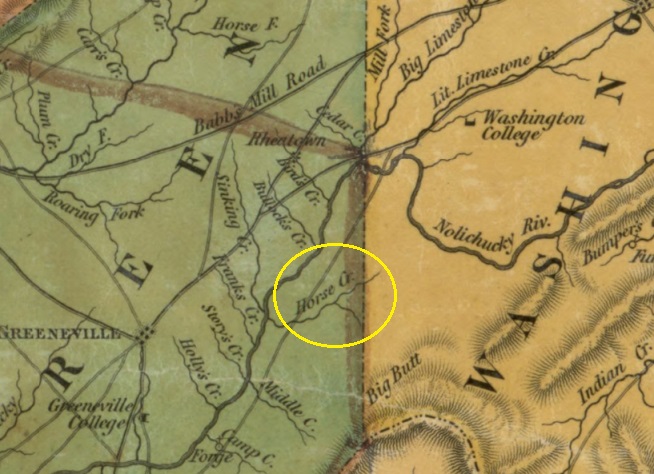
1832 Tennessee map showing Horse Creek on the county line
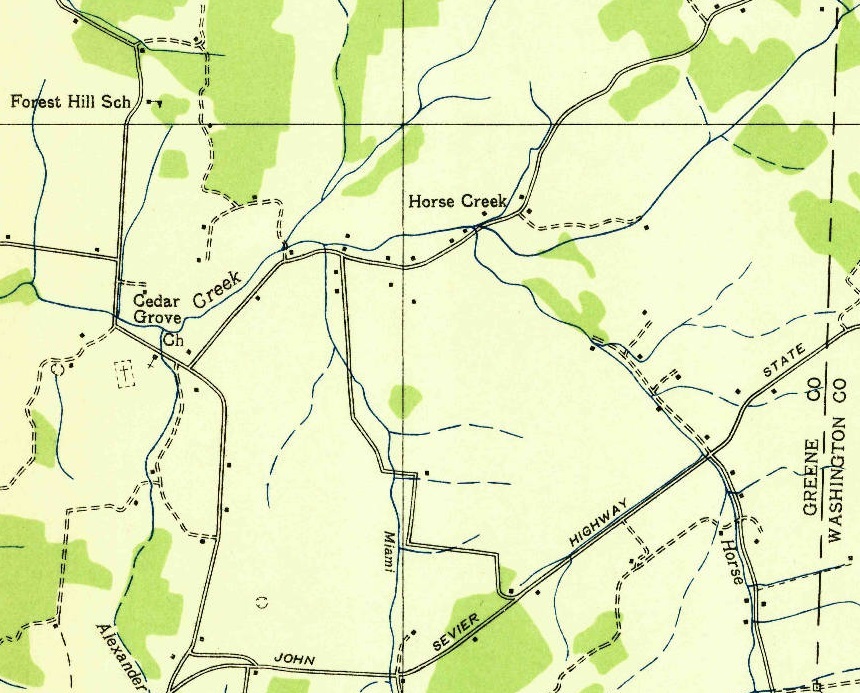
No census was taken in East Tennessee in 1790, during the first census of the United States.
East Tennessee censuses records for 1800, 1810, and 1820 were destroyed at the National Archives; no local copies are known to exist.
I am currently working with several land grants to figure out the exact parcels owned and farmed by Conrad. They are meets and bounds so pinpointing locations is difficult.
Notes:
1936 USGS map showing Horse Creek. Wilhoit Road runs from the Cedar Grove Church NE past Horse Creek and off the top right corner of the map.
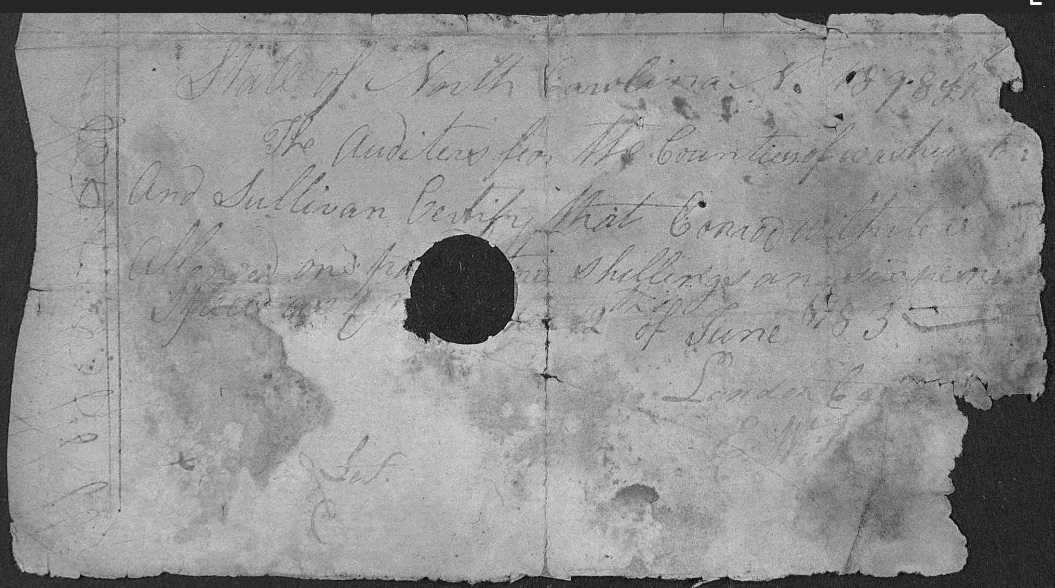
Conrad Wilhoit (spelled Wilhite) revolutionary war pay voucher
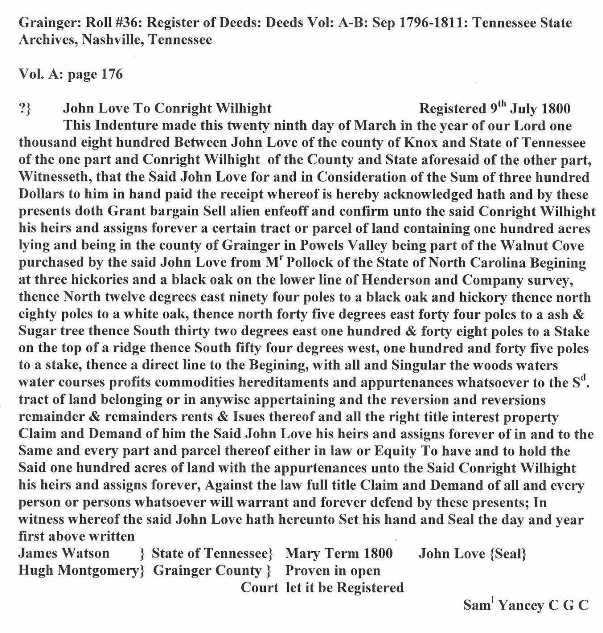
March 29, 1800 land purchase in Walnut Cove (town of Jacksbro) Powell Valley, Tennessee. Please contact me if you know this location.
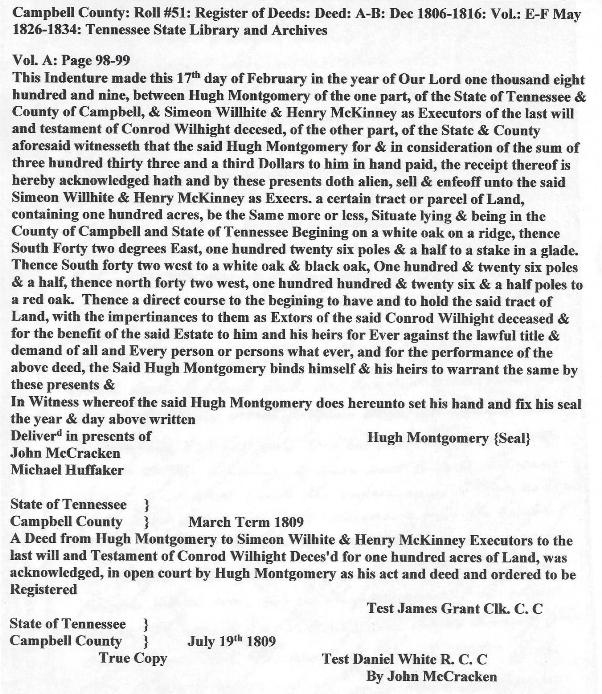
Feb 17, 1809 land sale to the executors of Conrad's last will and testiment. To Simeon Willhite and Henry Mckiney for $333.30 to Hugh Montgomery. Please contact me if you know this location.
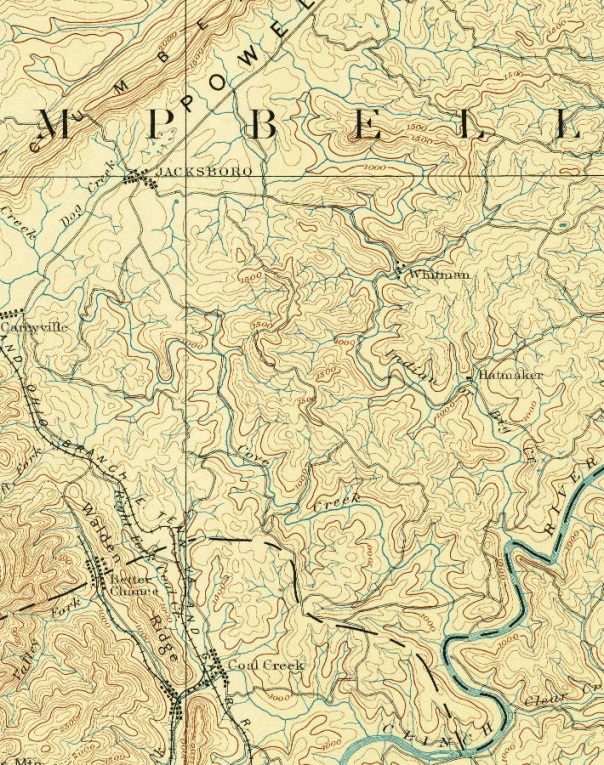
1893 map with Jacksboro and Indian Creek








